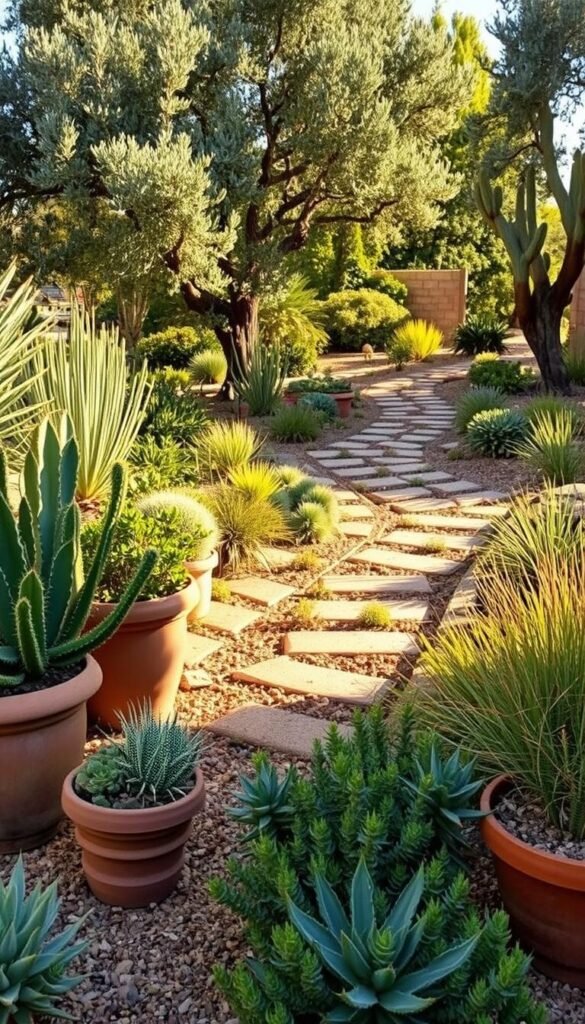Imagine transforming your outdoor space into a thriving, water-smart sanctuary that adapts to dry climates. With thoughtful planning, you can create a landscape that conserves resources while bursting with color and life. This approach isn’t about compromising beauty—it’s about working smarter with what nature provides.
By embracing drought-tolerant landscape design, you’ll cut water use dramatically—up to 80% compared to traditional setups. Native plants and strategic layouts reduce maintenance while supporting local pollinators. Even small spaces shine: container gardens using self-watering pots or moisture-retaining soil prove sustainability works at any scale.
Modern solutions like drip irrigation pair perfectly with natural techniques. Mulch locks in moisture, while grouping plants with similar needs minimizes competition. You’ll save time, money, and water—all while building an ecosystem that grows stronger through dry spells.
Introducing Your Water-Wise Garden Journey
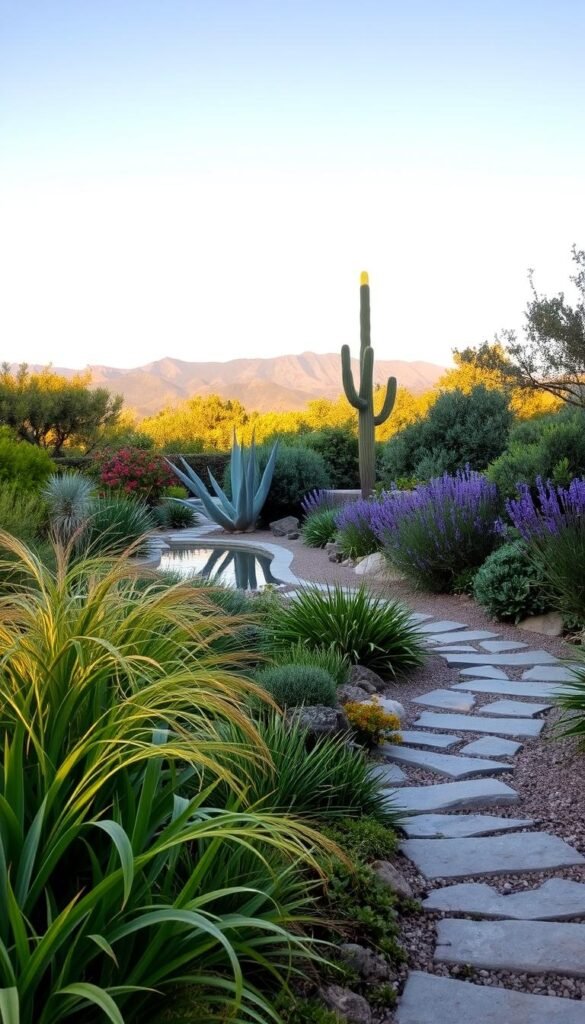
Creating a landscape that thrives in dry conditions begins with understanding nature’s patterns. Many homeowners face rising water bills and struggling plants as climate shifts reshape growing seasons. This guide helps you build an outdoor space that works with your environment, not against it.
Why Dry Landscapes Demand Smart Planning
Traditional yards waste thousands of gallons annually through evaporation and mismatched plant choices. Water conservation becomes crucial when dealing with irregular rainfall and prolonged dry spells. Modern solutions let you maintain vibrant colors and textures while using up to 80% less water than conventional setups.
Your Roadmap to Success
We’ll walk through proven methods that adapt to your specific region and soil type. Whether you’re upgrading an existing space or starting fresh, these strategies help:
- Reduce weekly maintenance by choosing self-sufficient plants
- Save money through efficient irrigation and soil improvements
- Support bees and butterflies with native species
You’ll discover how simple changes—like grouping plants by water needs—create landscapes that grow more robust each season. Let’s transform your outdoor area into a water-smart haven that flourishes year-round.
Understanding Drought Conditions and Climate Considerations
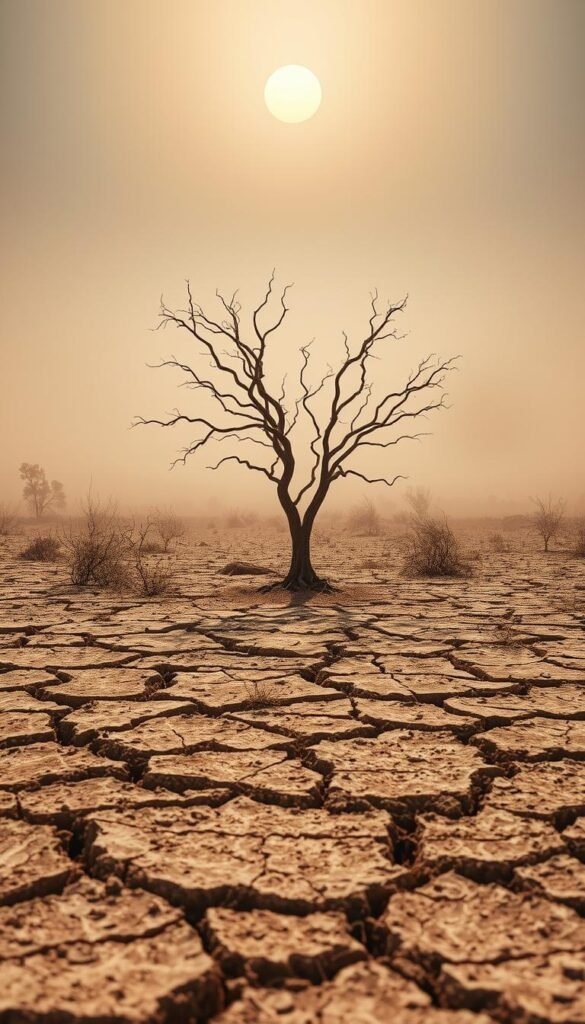
Your yard’s survival during dry spells starts with knowing your local climate. What works in Phoenix won’t thrive in Portland—soil types, rainfall patterns, and temperature swings shape your strategy. Let’s explore how to match your plans to nature’s rhythm.
Why Water Scarcity Changes Everything
When water becomes scarce, it affects more than thirsty plants. Beneficial insects disappear, and soil nutrients get locked away. You’ll notice:
- Shrinking puddles for pollinators
- Cracked earth that repels rainwater
- Plants competing for limited resources
America’s Diverse Dry Zones
From California’s chaparral to Texas’ clay soils, each region battles drought differently. Sandy soils drain fast, while heavy clay holds moisture unevenly. Consider these challenges:
- Southwest: Extreme heat + salty soil
- Midwest: Unpredictable dry periods
- Southeast: Humidity with sporadic rainfall
Track your property’s microclimates—sun-baked slopes need different care than shaded valleys. A simple soil test reveals pH levels and texture, helping you pick plants that thrive in your conditions without constant watering.
Selecting Drought-Resistant and Native Plants
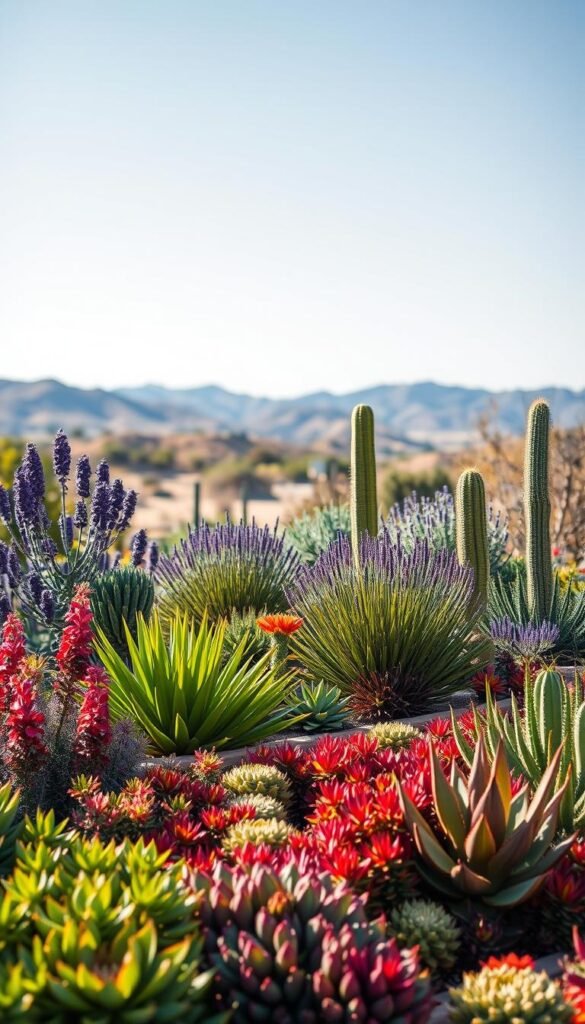
The secret to a lush yard in dry regions lies in choosing greenery that evolved for survival. Native species have spent centuries perfecting their adaptation to your area’s unique challenges. Let’s explore how these natural champions create vibrant landscapes while slashing water use.
Why Local Plants Outperform Imports
California poppies and black-eyed Susans aren’t just pretty faces—they’re hydration ninjas. These natives developed deep root systems that tap into groundwater reserves, needing up to 80% less water than exotic varieties. Yarrow’s feathery leaves minimize evaporation, while agave stores moisture in its fleshy core.
Ornamental grasses like blue fescue add texture without thirst. Their slender blades sway gracefully in breezes, creating movement that masks their low-maintenance nature. You’ll spend less time watering and more time enjoying.
Smart Placement = Lasting Beauty
Group plants with similar needs to create efficient watering zones. Cluster lavender with Russian sage—both thrive in dry, sunny spots. Place moisture-loving succulents like echeveria in separate beds with fast-draining soil.
Consider these pairing ideas:
- Sunny slopes: Coneflowers + feather reed grass
- Shaded corners: Fern-like yarrow + creeping thyme
- Rock gardens: Sedum varieties + dwarf agave
As these species mature, their roots dig deeper, making them increasingly self-sufficient. You’ll watch your landscape grow more vibrant each season—with minimal intervention.
Soil Preparation and Mulching Techniques for Enhanced Moisture
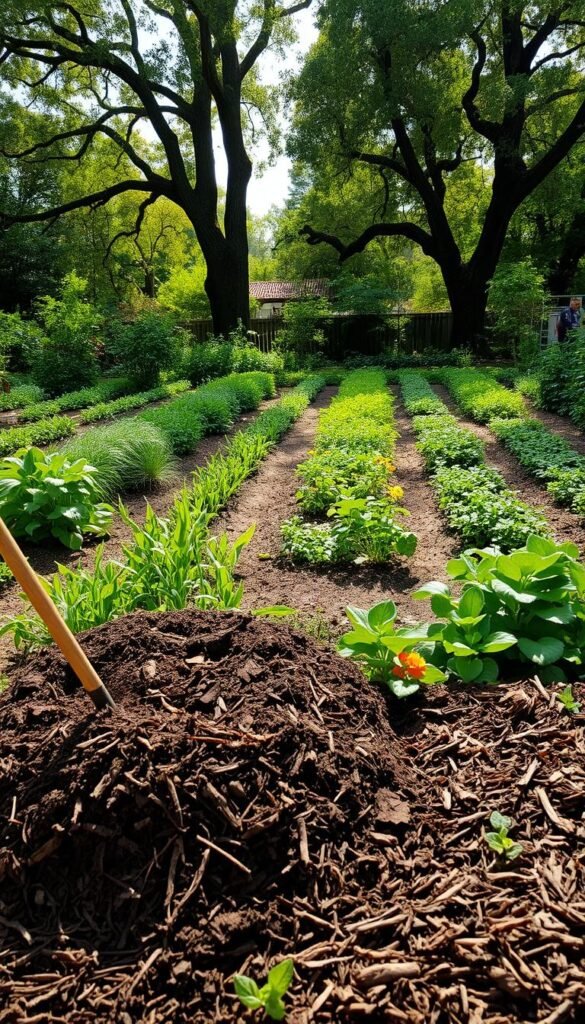
Healthy soil acts like a sponge, storing water for plants when rains are scarce. Building this natural reservoir starts with smart amendments and protective layers that keep roots hydrated through dry spells.
Building Better Ground
Mix 2-3 inches of compost or aged manure into your soil each year. This organic matter acts like tiny water balloons, boosting moisture retention by 30%. Even tough clay or sandy soils transform when blended with perlite—it creates air pockets for roots to breathe and drink deeply.
Mulch Magic
A 3-inch layer of wood chips or pine needles cuts evaporation by 70%. Keep mulch 2 inches from plant stems to avoid rot. As it breaks down, it feeds earthworms that naturally aerate your soil.
| Mulch Type | Water Retention | Best For |
|---|---|---|
| Wood Chips | High | Shrubs & Trees |
| Pine Needles | Medium | Acid-Loving Plants |
| Straw | Medium | Vegetable Beds |
For quick results, try leaf mold—it improves soil moisture within weeks. Combine with drip irrigation for a system that waters roots, not sidewalks. Your plants will stay hydrated longer, even when temperatures soar.
Efficient Irrigation Methods: Drip Systems and Smart Controllers
Upgrade your watering approach with precision technology that puts every drop to work. Modern solutions let you maintain healthy plants while slashing water use—no more guessing or waste.
Understanding Drip Irrigation and Its Benefits
Drip systems deliver water directly to roots through tiny emitters. Unlike sprinklers that spray air and pavement, these setups cut waste by 60%. They run efficiently at low pressure, perfect for areas with water restrictions.
Plants develop deeper roots as moisture seeps slowly into soil. This builds natural drought resistance over time. For budget-friendly setups, explore our guide on DIY irrigation ideas using basic tubing and timers.
Incorporating Weather-Based Smart Technology
Smart controllers adjust watering using live weather data. Connect to local forecasts through your phone—systems skip cycles when rain arrives or boost output during heatwaves. Some models even track soil moisture to prevent overwatering.
You’ll save 15-30% more water compared to manual schedules. Pair these gadgets with drip lines for a complete set-it-and-forget-it solution. Your plants get exactly what they need, precisely when they need it.
Integrating Xeriscaping and Hardscaping Principles
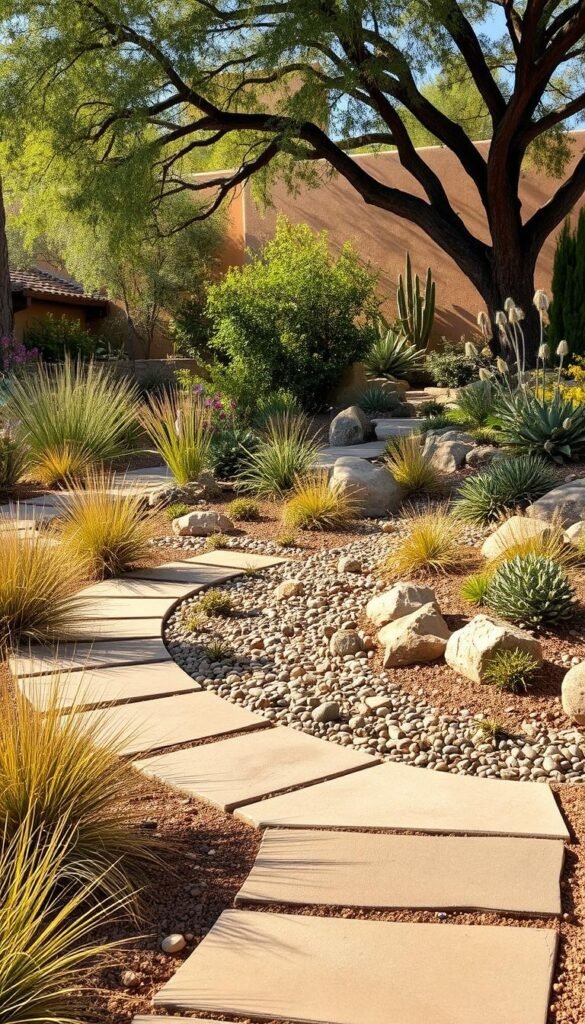
Transform your yard into a water-efficient masterpiece by blending thirsty plants with clever structural elements. This approach lets you maintain visual appeal while dramatically cutting outdoor water use. The key lies in strategic partnerships between greenery and built features.
Water Zone Planning Made Simple
Group vegetation by water needs to create efficient irrigation districts. High-water plants cluster near patios where runoff from hard surfaces naturally waters them. Moderate users occupy middle zones, while drought champions claim sunny slopes.
| Hydrozone Type | Water Needs | Plant Examples |
|---|---|---|
| High | Weekly watering | Hydrangeas, Ferns |
| Moderate | Bi-weekly | Lavender, Sage |
| Low | Monthly | Agave, Yucca |
Surfaces That Work With Nature
Replace concrete with gravel or decomposed granite—these permeable surfaces let rainwater soak into soil instead of creating runoff. For shaded retreats, position arbors where they block afternoon heat. Stone walls absorb daytime warmth, releasing it slowly to protect nearby plants.
In warm climates, use light-colored pavers to reflect sunlight. They stay cooler underfoot while reducing evaporation from surrounding soil. Your design becomes both functional and beautiful when every element serves multiple purposes.
Resilient Garden Design Strategies for Drought-Prone Areas
Creating a drought-smart landscape means blending nature’s wisdom with modern know-how. Focus on methods that strengthen plant health while conserving resources. Start by enriching your soil—mix in compost to boost water retention and microbial activity. This foundation supports deeper root growth, helping plants access moisture during dry spells.
Pair native species with clever planting techniques. Cluster flowers like blanketflower with shrubs such as manzanita—their complementary root systems share resources efficiently. For year-round interest, try a drought-resilient landscape plan that staggers bloom times and maximizes ground cover.
Try these synergistic approaches:
- Interplant herbs like rosemary with flowering perennials to deter pests naturally
- Use stone pathways to reduce evaporation and create thermal mass
- Install swales (shallow ditches) to redirect rainwater to thirsty plants
Smart maintenance keeps your space thriving. Prune in early spring to encourage bushier growth, and let fallen leaves nourish the soil. These practices build self-sustaining gardens that grow stronger through challenges while supporting butterflies, bees, and local wildlife.
Seasonal Maintenance and Adjusting for Weather Conditions
Keep your outdoor space thriving through every season with smart adjustments to your care routine. As temperatures shift, your plants’ needs change—adapting your approach prevents stress and conserves resources. Focus on three key areas: watering schedules, soil protection, and proactive plant care.
Timing Matters for Plant Health
Prune in late winter before new growth emerges. This timing helps plants recover faster while reducing disease risks. Pull weeds after rain when roots release easily, and spread mulch to block new invaders. Attract ladybugs and lacewings by planting dill or fennel—they’ll handle aphids naturally.
Water When It Counts Most
Cut irrigation by 30-40% during spring and fall when cooler weather slows evaporation. Water between 4-7 AM using drip lines—this timing keeps foliage dry, preventing mold. In mild winters, pause watering entirely once plants go dormant. For detailed month-by-month tips, explore our seasonal care guide.
Check soil moisture weekly by pressing two fingers into the ground. If it feels dry below the surface, give plants a deep drink. Adjust your system when heatwaves or storms arrive—smart controllers handle these changes automatically. With thoughtful maintenance, your landscape stays vibrant while using water wisely.

